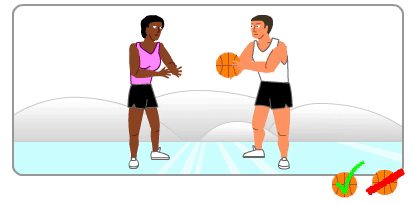fundamental? The modern atom model The scale of the atom What are we looking for? The standard model The standard model quiz
|
The unseen effect You can think about forces as being analogous to the following situation: Two people are standing on an ice pond. One person moves their arm and is pushed backwards; a moment later the other person grabs at an invisible object and is driven backwards. Even though you cannot see a basketball, you can assume that one person threw a basketball to the other person because you see its effect on the people. 
It turns out that all interactions which affect matter particles are due to an exchange of force carrier particles, a different type of particle altogether. These particles are like basketballs tossed between matter particles (which are like the basketball players). What we normally think of as "forces" are actually the effects of force carrier particles on matter particles. The basketball animation is, of course, a very crude analogy since it can only explain repulsive forces and gives no hint of how exchanging particles can result in attractive forces. We see examples of attractive forces in everyday life (such as magnets and gravity), and so we generally take it for granted that an object's presence can just affect another object. It is when we approach the deeper question, "How can two objects affect one another without touching?" that we propose that the invisible force could be an exchange of force carrier particles. Particle physicists have found that we can explain the force of one particle acting on another to INCREDIBLE precision by the exchange of these force carrier particles. One important thing to know about force carriers is that a particular force carrier particle can only be absorbed or produced by a matter particle which is affected by that particular force. For instance, electrons and protons have electric charge, so they can produce and absorb the electromagnetic force carrier, the photon. Neutrinos, on the other hand, have no electric charge, so they cannot absorb or produce photons.
 |





















